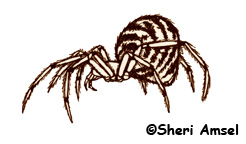

They are found throughout the U.S. and around the world.
They live in dry, warm areas of homes, barns and other buildings.
They are a large, brown spider with long legs. Females are up to ½” long and males are slightly smaller. They have an oblong abdomen with darker markings. Their legs are hairy and banded in light and dark brown.
They make irregular, sticky webs in and around buildings. They are known as “cobwebs.”
They eat small insects.
The female eats the male after mating. She lays many eggs in several white egg sacs that she hangs in her web.
Kingdom: Animalia
Phylum: Arthropoda
Class: Arachnida
Order: Araneae
Family: Theridiidae
Genus: Argyrodes
Species: A. tepidariorum
When you research information you must cite the reference. Citing for websites is different from citing from books, magazines and periodicals. The style of citing shown here is from the MLA Style Citations (Modern Language Association).
When citing a WEBSITE the general format is as follows.
Author Last Name, First Name(s). "Title: Subtitle of Part of Web Page, if appropriate." Title: Subtitle: Section of Page if appropriate. Sponsoring/Publishing Agency, If Given. Additional significant descriptive information. Date of Electronic Publication or other Date, such as Last Updated. Day Month Year of access < URL >.
Amsel, Sheri. "Spider (House)" Exploring Nature Educational Resource ©2005-2024. December 13, 2024
< http://www.exploringnature.org/db/view/Spider-House >

